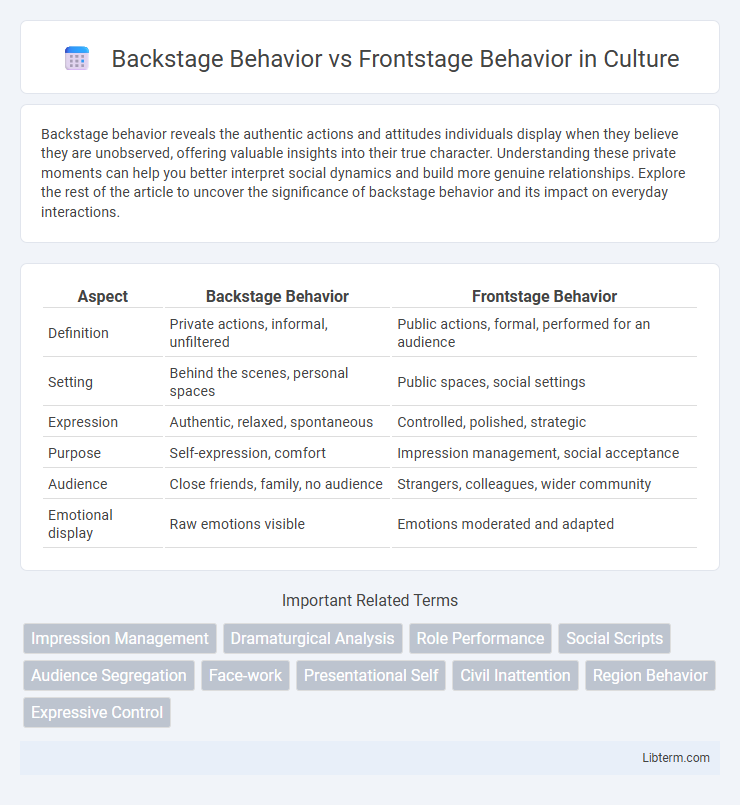Backstage behavior reveals the authentic actions and attitudes individuals display when they believe they are unobserved, offering valuable insights into their true character. Understanding these private moments can help you better interpret social dynamics and build more genuine relationships. Explore the rest of the article to uncover the significance of backstage behavior and its impact on everyday interactions.
Table of Comparison
| Aspect | Backstage Behavior | Frontstage Behavior |
|---|---|---|
| Definition | Private actions, informal, unfiltered | Public actions, formal, performed for an audience |
| Setting | Behind the scenes, personal spaces | Public spaces, social settings |
| Expression | Authentic, relaxed, spontaneous | Controlled, polished, strategic |
| Purpose | Self-expression, comfort | Impression management, social acceptance |
| Audience | Close friends, family, no audience | Strangers, colleagues, wider community |
| Emotional display | Raw emotions visible | Emotions moderated and adapted |
Introduction to Backstage and Frontstage Behavior
Backstage behavior refers to the private actions and expressions individuals display when they are away from the public eye, allowing authentic self-expression without social pressures. Frontstage behavior involves the curated performance people present in public or social settings, shaped by societal expectations and the desire to manage impressions. Understanding these concepts is crucial in social psychology and dramaturgy, as they explain how individuals navigate identity and social roles.
Understanding Erving Goffman's Dramaturgical Theory
Erving Goffman's dramaturgical theory distinguishes between frontstage behavior, where individuals perform roles in public settings to manage impressions, and backstage behavior, where they relax and express their true selves away from the audience. Understanding this dichotomy reveals how social interactions are orchestrated through controlled performances and authentic backstage preparations. This framework is essential for analyzing identity construction, social roles, and impression management in everyday life.
Key Differences Between Backstage and Frontstage Behavior
Backstage behavior involves individuals acting authentically, expressing true feelings and thoughts in private settings without concern for social judgment, while frontstage behavior is characterized by people performing roles and managing impressions to conform to societal expectations in public or formal contexts. Key differences include the level of self-presentation control, with frontstage requiring conscious impression management and backstage allowing relaxed, unrehearsed actions. The distinction highlights how social environments influence behavior, emphasizing the contrast between genuine self-expression and social role performance.
Examples of Frontstage Behavior in Everyday Life
Frontstage behavior is the social performance individuals display when they are in public or in the presence of others, often characterized by politeness, professionalism, and adherence to social norms. Examples include a waiter greeting customers with a smile, an employee maintaining a positive attitude during a meeting, or a student participating actively in class discussions. These behaviors are consciously managed to create a desired impression and maintain social order.
Backstage Behavior: What Happens Behind Closed Doors
Backstage behavior involves actions and expressions individuals display in private settings where social expectations and judgments are minimized. This behind-closed-doors conduct allows authentic self-presentation, free from the performative constraints seen in frontstage behavior. These private moments reveal true attitudes, emotions, and intentions that remain hidden during public interactions.
The Role of Social Norms in Shaping Behavior
Social norms critically influence the distinction between backstage and frontstage behavior by dictating acceptable conduct in public versus private settings. Individuals conform to these norms on the frontstage to maintain social order and positive impressions, while backstage behavior allows for relaxation of these norms in more private, intimate contexts. This dynamic underscores how social expectations shape and regulate behavioral expressions in different social environments.
Impacts on Personal Relationships and Interactions
Backstage behavior, characterized by authenticity and vulnerability, fosters deeper trust and emotional intimacy in personal relationships by allowing individuals to express true feelings without fear of judgment. Frontstage behavior, often managed and socially polished, can create surface-level interactions that maintain social harmony but may hinder genuine connection and understanding. Balancing these behaviors impacts relationship quality, as excessive frontstage behavior may lead to emotional distance, while appropriate backstage sharing strengthens bonds and promotes relational satisfaction.
Backstage and Frontstage in the Digital Age
Backstage behavior in the digital age refers to users' private, unfiltered interactions on platforms like encrypted messaging apps or closed social media groups, where authenticity and vulnerability are more common. Frontstage behavior involves curated online personas displayed on public profiles and social media feeds, emphasizing polished content designed for audience approval and social validation. The boundary between backstage and frontstage blurs as digital platforms enable selective self-presentation, influencing social dynamics and identity construction in virtual environments.
Psychological Effects of Managing Multiple Selves
Backstage behavior involves authentic self-expression in private settings, while frontstage behavior requires performing socially acceptable roles in public, leading to cognitive dissonance and emotional strain from managing conflicting identities. This duality often causes psychological stress, reduced self-esteem, and identity fragmentation as individuals constantly adjust their behavior to meet external expectations. Long-term compartmentalization between backstage and frontstage selves can impair authentic self-concept and increase anxiety disorders.
Conclusion: Balancing Authenticity and Social Expectations
Balancing authenticity and social expectations requires recognizing the dynamic interplay between backstage behavior, where individuals express true feelings and attitudes, and frontstage behavior, which involves presenting curated personas aligned with societal norms. Maintaining this equilibrium fosters genuine relationships while ensuring social harmony and acceptance. Embracing this balance enhances emotional well-being by allowing authentic self-expression within acceptable social frameworks.
Backstage Behavior Infographic

 libterm.com
libterm.com